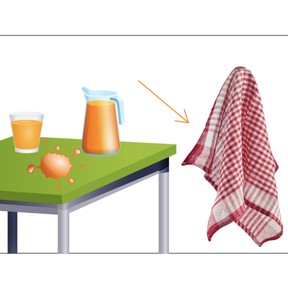



8,000 schools use Gynzy
92,000 teachers use Gynzy
1,600,000 students use Gynzy
General
Good scientists can analyze the results of experiences that they create in order to come up with conclusions about the world around them. Students will learn about the properties of matter and materials, and learn about and explore the observable property of absorbency. They will conduct an experiment where they will test the absorbency level of different everyday materials. This lesson includes activities where students watch a video and discuss ideas about absorbency, look at a scene and find absorbent objects, engage in an experiment where students get to determine the absorbency of four different materials, and participate in post-experiment activities that include sorting the materials experimented on by their absorbency and then applying their new-learned knowledge to help determine what material(s) would work best for a specific task. This lesson also includes printable worksheets.
Standards
NGSS: 2-PS1-2
Learning Objective
Students will be able to conduct an absorbency test to determine which types of material are best suited for specific tasks.
Introduction
Have students discuss which item, from a given list, would work best in the scenario described. Afterward, explain the best choice would be the dishrag because it is the most absorbent. Then, tell students that they will explore this concept in the lesson and experiment today!
Instruction
Teach students about the observable properties of matter. Explain that we can use our five senses to help us determine the observable properties of an object. Provide them an example of how to describe an item (e.g. the orange in the slides) by its observable properties. Then, define and explain the property of absorbency. Allow students to watch the video about what items are and aren’t absorbent and allow students to discuss or answer the questions after watching the video. Afterward, students can engage in the following activities:
First, students will look at a scene and use the draggable magnifying glass on the slide to find different items in the scene that are absorbent. Next, students will participate in a simple experiment to determine the levels of absorbency of four different materials. This experiment includes some data collected by the students during the experiment on a provided chart (on a slide and as a printable worksheet). After the experiment, students can discuss their results and answer the provided discussion questions. Additionally, they will have the opportunity to use their collected data to sort the four materials from least absorbent to most absorbent. Finally, students will use their new understanding of the observable property of absorbency to apply to an activity where they will design and write about a doll-house shelter that will satisfy specific criteria in a make-believe scenario.
Quiz
Students respond to ten questions about properties, the property of absorbency, and how specific materials are best suited for specific tasks based on their property of absorbency. The multiple-choice questions include fill-in-the-blank, multiple-choice, and sorting.
Closing
Students will be given a scenario where they have to design and explain a shelter that would best be suited for keeping a toy safe from the rain if left outdoors. Students will need to illustrate the shelter and then explain their thinking. This closing activity includes a printable worksheet.
Instruction materials
For this lesson’s experiment, the following materials will be needed: pencils, clear plastic cups, water, paper towel, felt, aluminum foil, cardboard, and scissors. This lesson also includes two printable worksheets.
The online teaching platform for interactive whiteboards and displays in schools
Save time building lessons
Manage the classroom more efficiently
Increase student engagement
Discover more!
About Gynzy
Gynzy is an online teaching platform for interactive whiteboards and displays in schools.
With a focus on elementary education, Gynzy’s Whiteboard, digital tools, and activities make it easy for teachers to save time building lessons, increase student engagement, and make classroom management more efficient.



